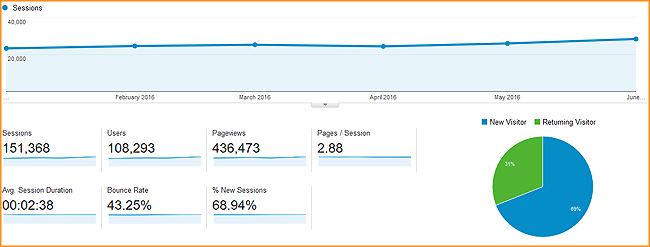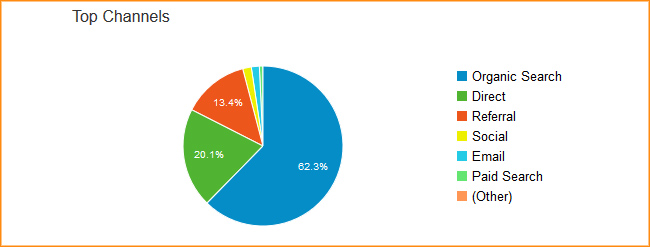Learn More About Our Branding Design & Development Solutions
Demystifying Analytics: Visitors, Visits, & Pageviews
Determining what to focus on in your website analytics & reporting in addition to understanding the differences between similar sounding metrics can be a challenge. This page contains some basic information about what metrics you should focus and what they mean. We answer questions such as:
- What metrics are the most important?
- How do I measure my website’s effectiveness?
- What types of things can be tracked?
Let’s start from the beginning. Your website analytics data can be broken down into three basic categories:
- Audience: Visitors, Visits, and Pageviews
- Acquisition: Channels and Sources
- User Behavior: Events and Goals
How many people are looking at my site? Do they come back? How many pageviews do I have?

Visitors (referred to as “Users” in Google Analytics) are the people that come to your site. Looking at the total number of visitors who come to your site is an important metric. You should also pay attention to the following subsets:
- Unique Visitors counts the number of individuals that have come to your site during a given period of time. Because people have so many devices, it’s hard to know if the same person came back on another device (i.e. if they looked at your site on their work computer, and on their phone later). It’s better to think of Unique Visitors as Unique Devices.
- New Visitors are visitors that came to your site for the first time during a given period of time. They could be real first-time visitors, but user-set privacy settings and the fact that many people have computers and phones can hide that they have seen the site before. Because of this, New Visitors is becoming a less important statistic.
- Returning Visitors are visitors who have come back to your site more than once on the same device. While this number definitely shows people who have looked at the site more than once, it’s probably under-reporting because of the reasons above.
Visits (referred to as Sessions in Google Analytics) count the number of times users have visited your site for any length of time. Some metrics you should focus on related to Visits include:
- Average Session Duration: How long did visitors spend on your site? Did visitors using the Chrome browser spend less than 30 seconds on the site, while Firefox users spend several minutes? Looking at session duration can help pinpoint problems that need to be fixed, like a bug making the site unusable on certain browsers or devices.
- Average Bounce Rate: The bounce rate for a site is the average rate at which a user visits your site, looks at a single page, and leaves. A person that clicks on a search result from your site, looks at the page for one minute, and doesn’t go anywhere else on your site is also considered a bounce. Bounce rates can also help show disconnects between site content and how users get there. For example, if visitors coming from paid social media ads have a 95% bounce rate and only spend 10 seconds on the site, your content in the ad and on the landing page may not match up.
Are Pageviews important? Pageviews used to be a popular metric – it’s cool to see just how many eyes are on your pages, and it’s usually the largest number in your dashboard. However, statistics that show us how people are using your site like how long they stay, what pages they leave from, and what they did are much more useful in gauging the effectiveness of your website.
How do people get to my site in the first place?

There are a number of different Channels that site visitors can come from. Channels are groupings of traffic sources of the same type, like search engines and social media sites.
- Organic Search refers to visits via search engines like Google, Bing, Baidu, and others.
- Direct, which also sometimes appears as (none), traffic means the user typed your site’s URL into their browser, or they had it saved as a bookmark. Users who are browsing with higher privacy settings may be counted in this area as well.
- Referral traffic arrives on your site by clicking a link on another website that is not a search engine, social network, or a correctly-tagged paid advertisement.
- Social traffic counts visits that originated from sites like Facebook, Twitter, Reddit, and other social media sites.
- Email traffic is the result of clicking a link in an email that is correctly tagged. Using an email service provider like Campaign Monitor will generally tag your links automatically so they will be attributed. If the email links are not correctly tagged, they are usually counted in Direct by mistake.
- Display and Paid Search traffic comes via ads. Display ads are generally graphics and are placed on other websites. Paid Search ads are text-based and appear in search results, like Google AdWords.
How can I track specific actions on my site?
If you’re using Google Analytics, defining Events and Goals on your website with tracking codes allows you to measure how people use specific content and resources on your site. A review of your business objectives will help you determine what actions you should be measuring.
Examples of Events and Goals trackable on websites could include:
- Event: How many times users clicked “Find a store” from buttons on product pages
- Goal: How often users who visited from paid search downloaded a white paper
- Event: Tracking visits to a page linked to from a promotion on your homepage
- Goal: Finding out the percentage of visitors who requested a quote after looking at a product page
Contact Us to discuss your digital marketing program.





